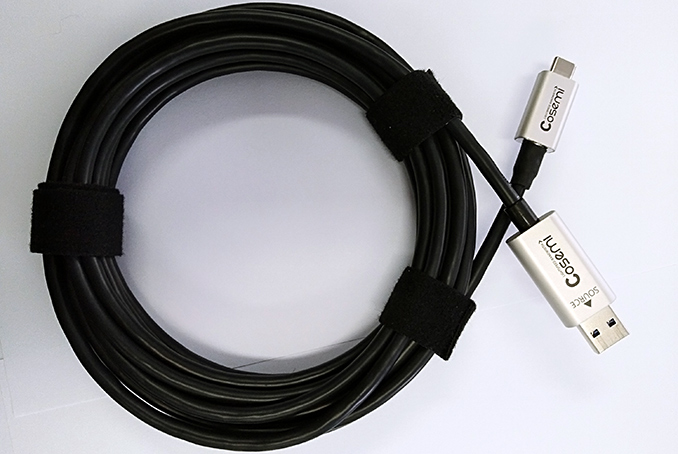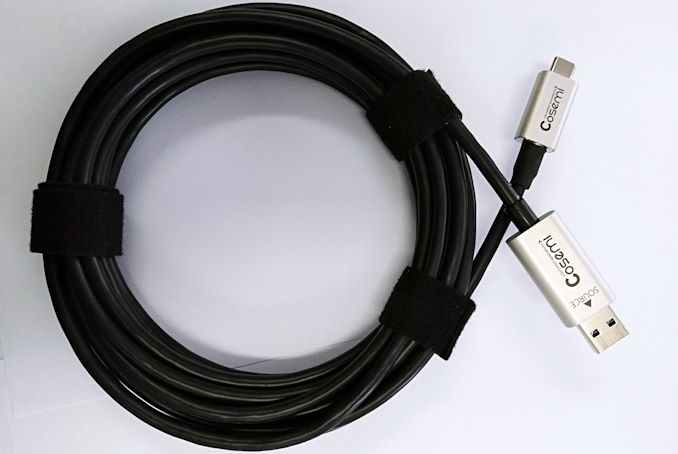Cosemi Launches USB 3.1 Gen 2 Hybrid Active Optical Cable: Up to 50 Meters of USB
by Anton Shilov on February 12, 2019 1:30 PM EST- Posted in
- Peripherals
- USB-C
- Cosemi
- USB

Cosemi has introduced the industry’s first USB 3.1 Gen 2 hybrid active optical cables (hAOC), which enable USB connectivity over distances upwards of 50 meters. The cables will be available with various connectors and therefore will be able to address various applications.
As you might guess from the name, Cosemi’s USB 3.1 Gen 2 hybrid active optical cables use fiber optics for data transfers, which is further paired with copper wires for control and power. The data portion of the cable is fully USB SuperSpeed+ capable, meaning it can transfer 10Gbps in each direction. Notable, since hAOCs can power themselves, unlike other solutions they do not need any extension boxes or repeaters, making them simpler and more reliable. Using fiber for the data channel also means that the cables are more resistant against EM and RF interference, which is particularly important for medical applications.
The manufacturer plans to offer hAOCs with various types of connectors, including USB Type-A to USB Type-A, USB Type-A to USB Type-C, as well as USB Type-C to USB Type-C, with A-to-C cables being the first type out the door. And while the cables are best geared for high bandwidth applications, like copper USB 3.1 Gen 2 cables, the hybrid active optical cables are backwards compatible with the USB 2.0 spec.
Last but not least, it's interesting to note that Cosemi’s hAOCs do not use PVC. As it turns out, this is a requirement for in-wall cables in the Americas, EMEA and Asia, as PVC produces toxic smoke when it burns.
Cosemi’s USB 3.1 Gen 2 hybrid active optical cables are sampling today, and mass production is set to start in March. The devices will be available later this year from various Cosemi’s partners, including Amazon, Liberty AV Solutions, and other. The manufacturer is not setting an MSRP quite yet, but tells us to expect them to be “competitive to USB extension box solutions.”
Related Reading:
Source: Cosemi











39 Comments
View All Comments
boozed - Tuesday, February 12, 2019 - link
What is something like this used for?yzzir - Tuesday, February 12, 2019 - link
I could see this being useful for high bandwidth USB cameras or other video interfaces using usb-c alt mode.BedfordTim - Wednesday, February 13, 2019 - link
In theory yet, but in practice it has been an expensive nightmare. My advice is stick with GigE unless you are really desperate.SirMaster - Tuesday, February 12, 2019 - link
I like a "silent" PC.So I put my PC in the basement and run USB and display wires up through the walls into the computer room to the desk where I have a USB hub and monitors.
BedfordTim - Wednesday, February 13, 2019 - link
Check the bend radius. On the older versions we used this would have been challenging at best. This is also a lot more expensive than cat 6 cable.MamiyaOtaru - Wednesday, February 13, 2019 - link
similar case here. For LAN parties, one very capable machine is in another room, and a PITA to move. I keep a spare monitor, keyboard and mouse in the gaming room, and when LANs happen run 50 foot cables from that machine into the spare KBM. It's all analog: ps/2 for keyboard and mouse, vga for video and regular audio jack. Most digital stuff just doesn't go that far, without repeaters or optical or whateverReflex - Wednesday, February 13, 2019 - link
You'd probably spend less in both time and money just building a silent PC. It's not hard to do these days, lots of SFF cases, power supplies and system fans are available for such projects. Mine is silent, the power supply fan won't spin up unless under heavy load (and that's usually when gaming and so I can't hear it anyway), same is true of the GPU fan, and the CPU fan is a low rotation Noctua that does a great job. Can't hear my system even with your head against it for normal desktop use.chx1975 - Thursday, February 14, 2019 - link
You can easily run HDMI and USB both over Cat 5e or Cat 6 cables, both have cheap converters to RJ45. It won't be Ethernet, it uses them as convenient very high bandwidth cabling.saratoga4 - Wednesday, February 13, 2019 - link
There is a lot of interest in optical USB for things like industrial equipment where you want to be electrically isolated AND to have long cable runs from a piece of machinery to a control system. Industry is driving demand for these. Probably makes sense to also sell the same parts to consumers who want to do long cable runs of USB, so no surprise someone is reselling industrial parts back to consumers.boozed - Friday, February 15, 2019 - link
That might explain the complete lack of application examples in the marketing material. If you have to ask... you don't need it.